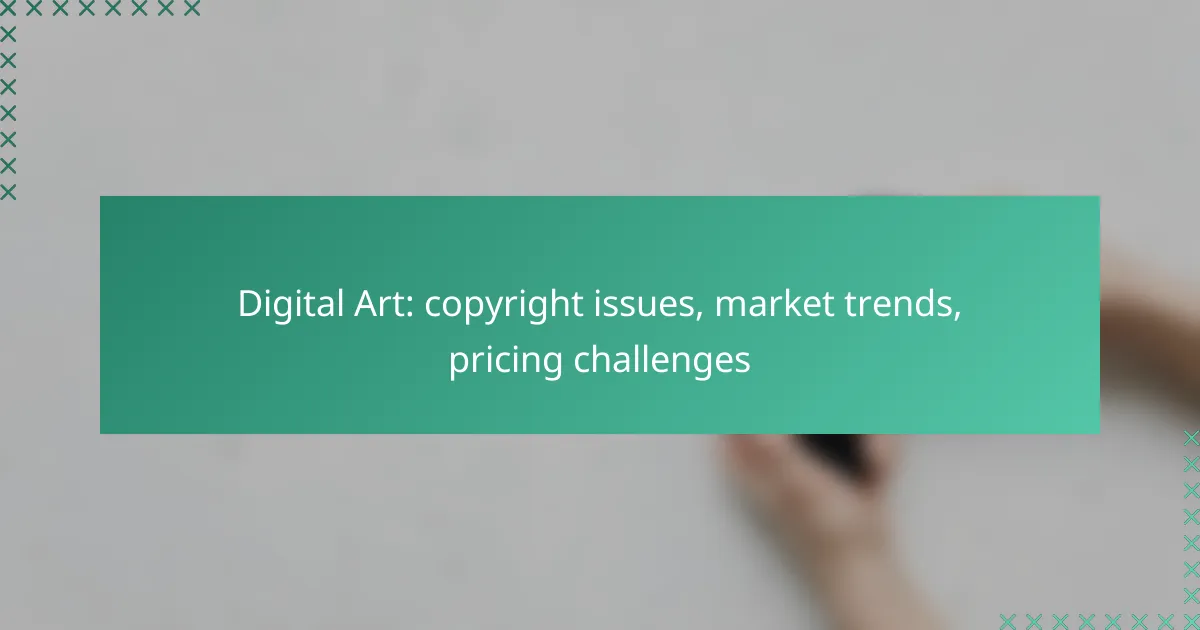The landscape of digital art is fraught with challenges, particularly concerning copyright issues that involve ownership, fair use, and licensing. As market trends evolve, influenced by phenomena like NFTs and social media, artists face difficulties in pricing their work appropriately while ensuring they receive due recognition and compensation.
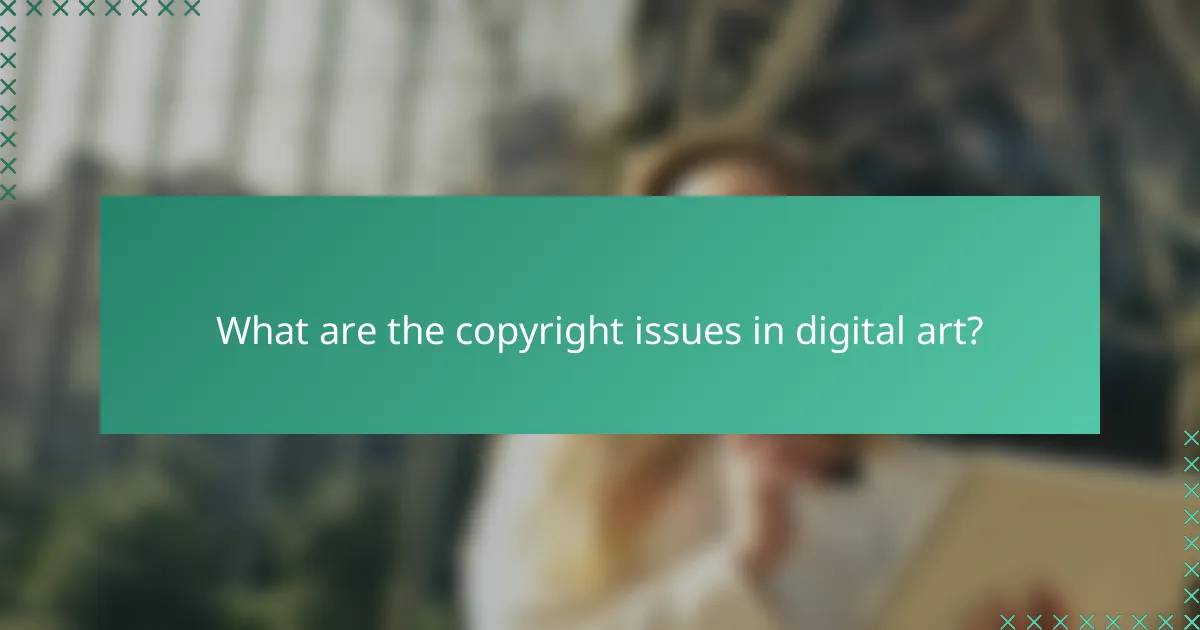
What are the copyright issues in digital art?
Copyright issues in digital art primarily revolve around ownership, fair use, and licensing. Artists must navigate these complexities to protect their work and ensure they receive proper credit and compensation.
Ownership rights of digital artworks
Ownership rights in digital art can be complicated due to the ease of reproduction and distribution. Generally, the creator of a digital artwork holds the copyright, but this can vary if the work is created under a contract or as part of employment. Artists should clearly define ownership in any agreements to avoid disputes.
When selling digital art, artists often transfer certain rights to buyers while retaining others, such as the right to reproduce or display the work. It’s crucial to specify which rights are included in the sale to prevent misunderstandings.
Fair use implications for digital artists
Fair use allows limited use of copyrighted material without permission, but it is a nuanced area for digital artists. Factors such as the purpose of use, the nature of the original work, the amount used, and the effect on the market value are considered in determining fair use. Artists should be cautious when using others’ work, as misinterpretation can lead to legal issues.
For example, using a small portion of a digital artwork for commentary or criticism may qualify as fair use, while reproducing an entire piece for commercial purposes likely does not. Understanding these implications is essential for protecting one’s own work and respecting others’ rights.
Licensing agreements for digital art
Licensing agreements are essential for digital artists to outline how their work can be used by others. These agreements can specify terms such as duration, territory, and exclusivity, allowing artists to retain control over their creations. Clear licensing terms help prevent unauthorized use and ensure artists are compensated fairly.
Common types of licenses include exclusive, non-exclusive, and rights-managed licenses. Artists should consider their goals when choosing a licensing model, as each has different implications for income and control over the artwork. Consulting a legal professional can provide valuable guidance in drafting effective licensing agreements.
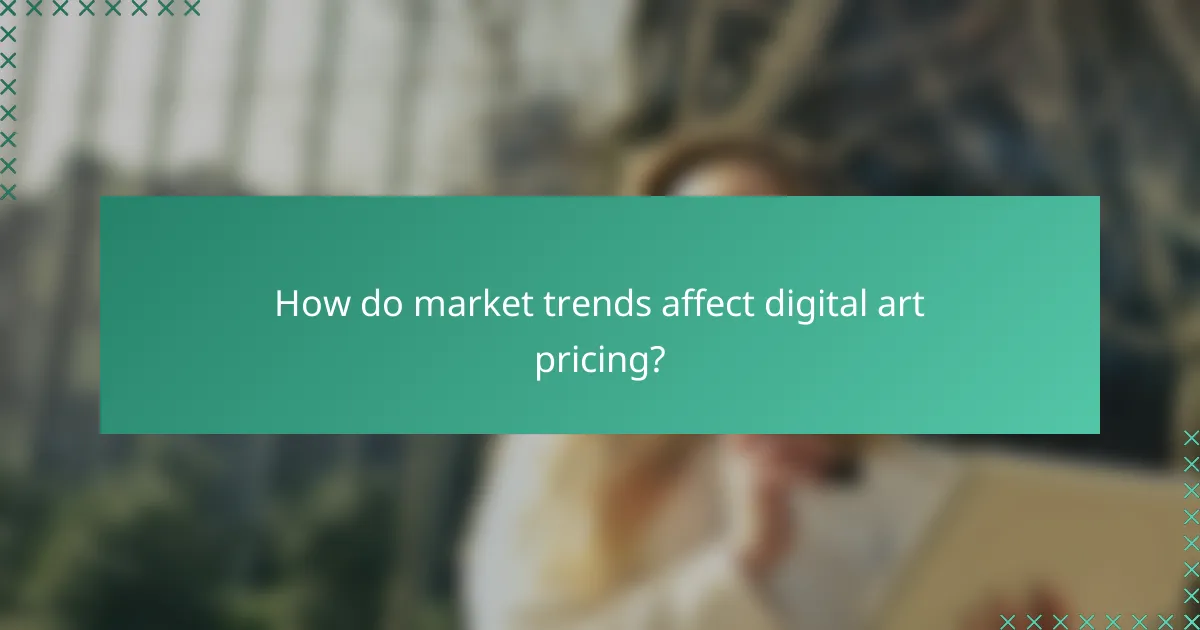
How do market trends affect digital art pricing?
Market trends significantly influence digital art pricing by shaping demand and perceived value. Factors such as the rise of NFTs and the role of social media can create fluctuations in prices, making it essential for artists and buyers to stay informed about these dynamics.
Impact of NFT popularity on digital art sales
The popularity of NFTs has transformed the digital art landscape, allowing artists to sell unique pieces directly to collectors. This shift has led to some artworks fetching prices in the thousands or even millions of dollars, depending on the artist’s reputation and the rarity of the piece.
However, the NFT market can be volatile. Prices can soar during hype cycles and plummet when interest wanes. Artists should consider diversifying their sales strategies beyond NFTs to mitigate risks associated with market fluctuations.
Influence of social media on digital art market
Social media platforms play a crucial role in promoting digital art and influencing pricing. Artists can showcase their work to a global audience, which can lead to increased demand and higher prices. Platforms like Instagram and TikTok allow for viral marketing, which can elevate an artist’s profile almost overnight.
Nevertheless, relying solely on social media can be risky. Trends can change rapidly, and what is popular today may not be tomorrow. Artists should engage with their audience consistently and explore multiple channels to build a sustainable presence in the market.
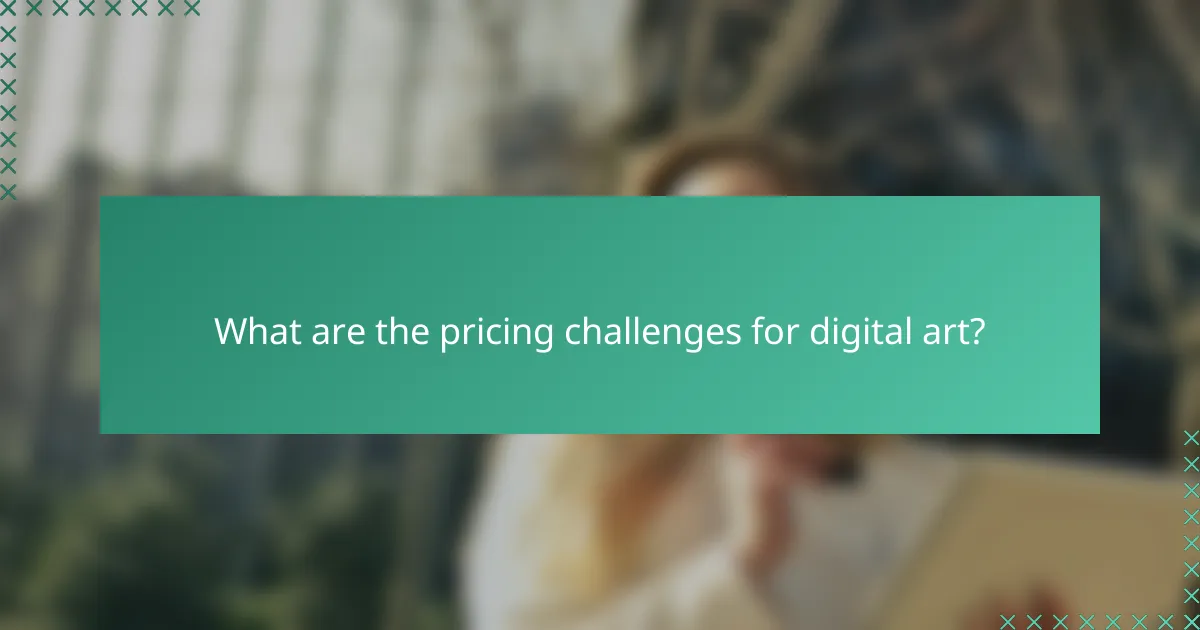
What are the pricing challenges for digital art?
Pricing digital art can be complex due to factors like market demand, artist reputation, and the unique nature of digital ownership. Artists often struggle to determine a fair price that reflects their work’s value while remaining competitive in a rapidly evolving market.
Valuation methods for digital artworks
Valuing digital artworks typically involves several methods, including cost-based, market-based, and income-based approaches. The cost-based method considers the time and resources invested in creating the piece, while the market-based approach looks at similar works’ selling prices. The income-based method estimates potential future earnings from the artwork, which can be challenging to predict in the digital space.
Artists should also consider the uniqueness of their work, especially if it includes limited editions or is tied to non-fungible tokens (NFTs). These factors can significantly influence perceived value and pricing.
Pricing strategies for emerging digital artists
Emerging digital artists can adopt several pricing strategies to establish their market presence. Offering lower prices initially can attract buyers and build a portfolio, but it’s essential to gradually increase prices as demand grows. Artists should also consider tiered pricing for different formats or editions of their work.
Networking within online communities and participating in digital art marketplaces can provide insights into current trends and pricing benchmarks. Additionally, artists should avoid undervaluing their work, as this can set a precedent that is hard to change later.

What criteria should artists consider for copyright protection?
Artists should consider originality, fixation, and the scope of protection when seeking copyright for their digital art. Originality ensures that the work is unique, fixation means it is captured in a tangible form, and understanding the scope helps in knowing what rights are granted and how to enforce them.
Registration processes for digital art copyrights
The registration process for digital art copyrights typically involves submitting an application to the relevant copyright office, such as the U.S. Copyright Office. This application usually requires a copy of the artwork, a completed form, and a fee that can range from around $35 to $55 depending on the method of submission.
Once submitted, the registration can take several months to process. However, registering your work provides legal advantages, such as the ability to sue for statutory damages and attorney fees in case of infringement.
Importance of watermarking digital artworks
Watermarking digital artworks is crucial for protecting against unauthorized use and theft. A visible watermark can deter potential infringers by clearly indicating ownership, while an invisible watermark can help track the art if it is used without permission.
When creating a watermark, ensure it is subtle yet noticeable enough to discourage misuse. Consider placing it in a corner or across the center of the artwork, and use a design that does not detract from the overall aesthetic of the piece.

How can digital artists navigate copyright disputes?
Digital artists can navigate copyright disputes by understanding their rights and taking proactive steps to protect their work. This includes familiarizing themselves with copyright laws, documenting their creations, and knowing how to respond if their work is infringed upon.
Steps to resolve copyright infringement claims
When faced with copyright infringement, artists should first gather evidence of their original work and the infringement itself. This may include screenshots, timestamps, and any relevant communications. Next, they should reach out to the infringer directly, requesting that the unauthorized use cease.
If direct communication fails, artists can file a formal complaint with the platform hosting the infringing content. Many platforms have established procedures for reporting copyright violations, which can lead to the removal of the infringing material.
In more severe cases, seeking legal advice may be necessary. Artists should consider whether pursuing legal action is worth the potential costs and time involved.
Legal resources for digital artists
Digital artists can access various legal resources to help navigate copyright issues. Organizations like the Copyright Office provide valuable information on copyright registration and protection. Additionally, legal aid clinics often offer free or low-cost consultations for artists facing copyright challenges.
Online platforms such as Creative Commons allow artists to license their work under specific terms, helping to clarify usage rights. Furthermore, joining professional organizations can provide access to legal resources and support networks.
Artists should also consider using copyright management tools that help track usage and provide alerts for unauthorized use, ensuring they stay informed about their rights and protections.
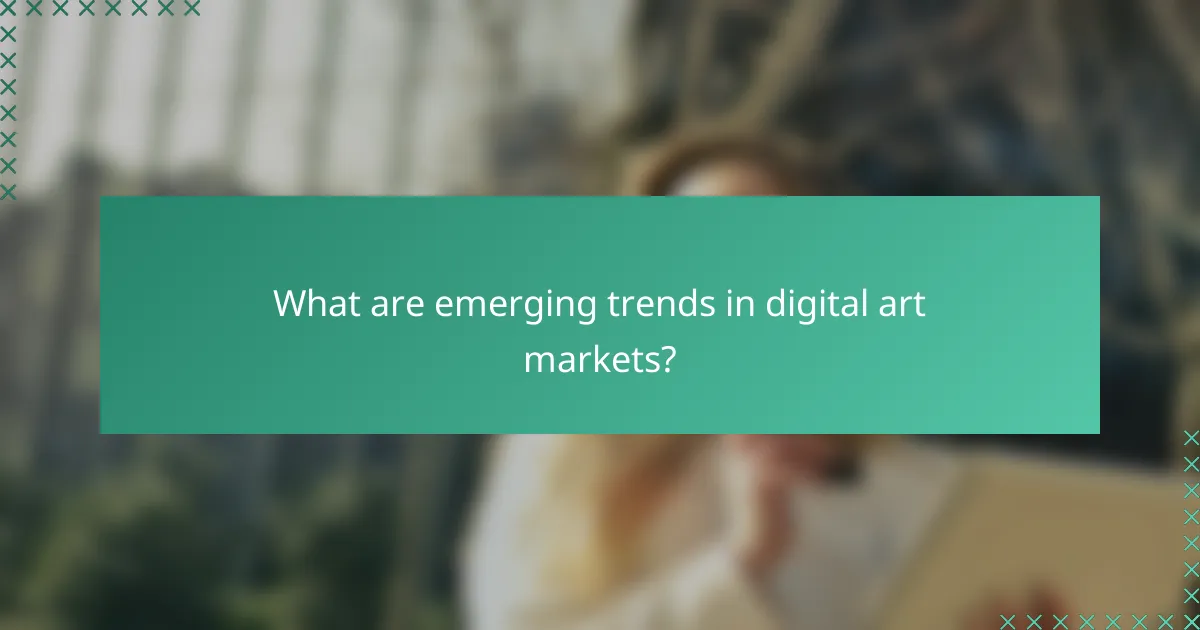
What are emerging trends in digital art markets?
Emerging trends in digital art markets include the increasing integration of virtual reality (VR) and the rise of AI-generated artworks. These developments are reshaping how art is created, consumed, and valued, presenting both opportunities and challenges for artists and collectors alike.
Growth of virtual reality in digital art
The growth of virtual reality in digital art is transforming the way audiences experience and interact with art. VR allows artists to create immersive environments where viewers can engage with their work in a three-dimensional space, enhancing emotional and sensory connections.
Artists can leverage platforms like Oculus and HTC Vive to showcase their VR art, often leading to higher engagement rates and sales. However, the technology can be costly, and artists must consider the investment in hardware and software when entering this market.
Future of AI-generated art and copyright
The future of AI-generated art raises significant questions regarding copyright and ownership. As AI tools become more sophisticated, they can produce unique artworks, leading to debates about who holds the rights to these creations—the artist, the programmer, or the AI itself.
Current copyright laws in many countries, including the U.S. and EU, are still adapting to these advancements. Artists should be cautious and seek legal advice to navigate potential copyright issues, ensuring they protect their original works while exploring AI technologies.
